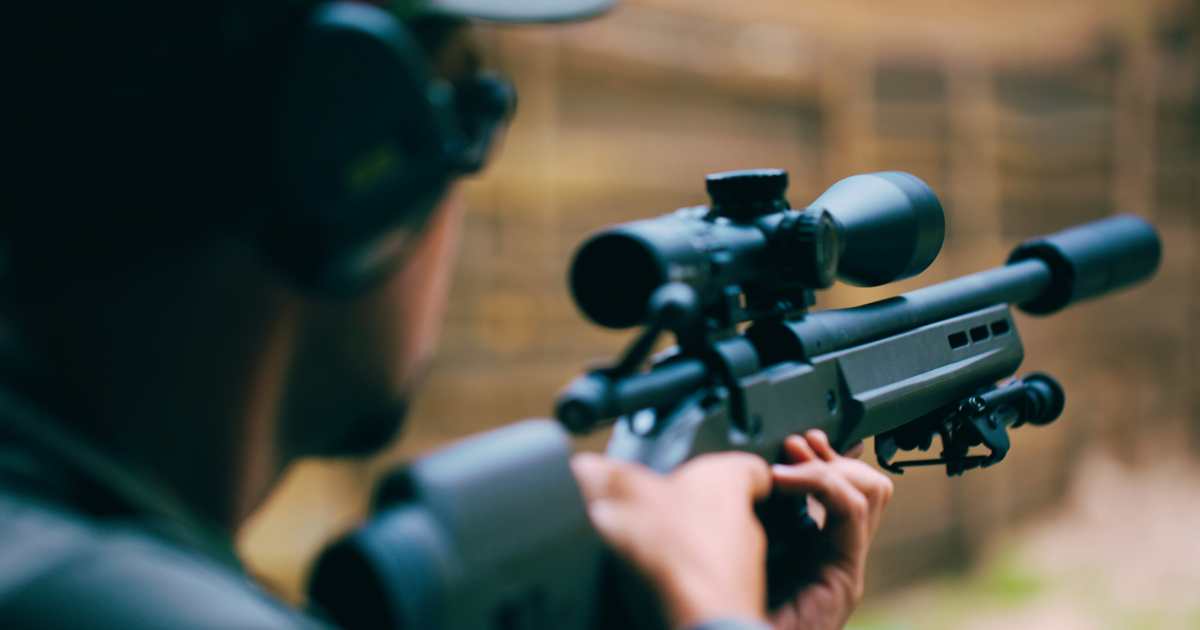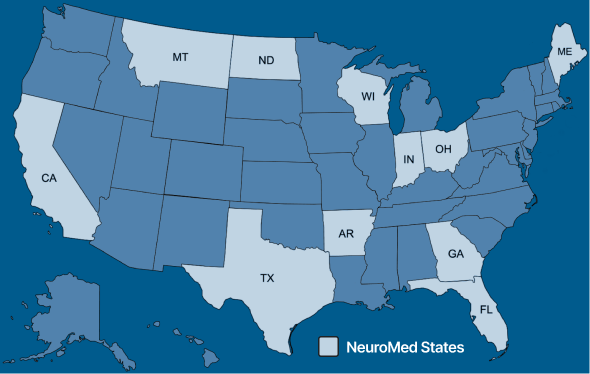Tinnitus Retraining Therapy: Merits and Flaws
As a tinnitus specialist, I’m frequently asked about the merits of Tinnitus Retraining Therapy (TRT). Here, I offer a critical review where you’ll learn answers to these questions:
- What is Tinnitus Retraining Therapy?
- What is tinnitus counseling in TRT?
- What is sound therapy in TRT?
- How much does TRT cost?
- Does Tinnitus Retraining Therapy work?
- What is the #1 flaw with Tinnitus Retraining Therapy?
What is Tinnitus Retraining Therapy?
Tinnitus Retraining Therapy (TRT) is a method of treating tinnitus that combines psychoeducation with tinnitus masking. The method was developed by audiologist Pawel Jastreboff, PhD, in the 1990s. Tinnitus Retraining Therapy is based on the Neurophysiological Model of tinnitus, a model introduced by Jastreboff himself.
This tinnitus treatment method has helped thousands of people achieve lasting relief from tinnitus. However, when put head-to-head in randomized controlled studies, it did no better than standard therapy. So what’s going on?
Here I’m going to present some candid thoughts on TRT from the point of view of a tinnitus specialist. I’ll give you the background, then the evidence, and then my understanding of what TRT lacks. I’ll also include information on how much tinnitus retraining therapy costs and my take on online tinnitus retraining therapy.
What happens in Tinnitus Retraining Therapy?

Tinnitus Retraining Therapy (TRT) basically gives patients a graduate-level course on tinnitus and the auditory system, delivers a masking device and sound therapy education, and then provides emotional support over the course of two years.
The first visit is REALLY long, sometimes lasting up to 6 hours. In fact, it’s usually broken up into several days. There are four things on the initial visit agenda:
- Initial Interview and Testing: This is where you explain in detail what your tinnitus is like, followed by extensive testing of middle ear problems, hearing loss in one or both ears, and specifics about your tinnitus frequency.
- Medical History: This step makes sure that treatable medical conditions related to tinnitus are ruled out. This part is sometimes performed by an ENT doctor. Special attention is given to screen for hyperacusis, a condition where loud noises cause pain and discomfort.
- Tinnitus Counseling: This is where you get your degree in tinnitus science. Basically, you are taught the basic principles of the neurophysiological model of tinnitus.
- Sound Therapy: The final step in the initial TRT is how to use sound therapy. Here you’re offered various sound therapy options, instructed to avoid silence, and encouraged not to completely cover their tinnitus. It usually includes the sale of either hearing aids for tinnitus or ear-level masking devices (looks like a hearing aid).
Next you have a series of followup visits where your audiologist reinforces the model and discusses your progress. The typical cadence of treatment is to follow up at 1, 3, 6, 12, and 18 months. Some packages include more frequent visits, but in general, the minimum length of the program is 12 months.
I agree that there’s no quick fix for tinnitus, but 12 months is rather long!
"I learned more about my tinnitus in the intro call than from my doctor..."
– Alice Lee

Ready for relief? NeuroMed can help.
What is “Tinnitus Counseling” in TRT?
The primary goal of tinnitus counseling in TRT is to demystify tinnitus. When people know what’s going on with their tinnitus, it gives them a sense of empowerment. They are taught the Neurophysiological Model of Tinnitus (see Addendum below).
Here is a list of key concepts taught in the first TRT session. This is modified from a handout from a well known TRT protocol that’s given to patients after the first visit [1].
| TRT Concept | Concept Explanation |
|---|---|
| The goal of TRT is to change your mind. | TRT helps your brain to reclassify the tinnitus signal from “dangerous” to “unimportant”. This is not a conscious process; you can’t force your mind to do it. However, if you understand the goal and use sound therapy properly, it will stop tinnitus from activating your fear center. |
| Tinnitus is not the same thing as hearing loss. | While the two usually go together, tinnitus does not mean you are actively losing hearing. Tinnitus is not a warning sign that you’re losing hearing. Basically, don’t freak out about your hearing. |
| The brain makes tinnitus loud and annoying, not your ear. | Loudness and annoyance are related to the strength of negative feelings you have regarding the tinnitus signal. The emotional part of your brain and your autonomic nervous system are what makes tinnitus annoying, not your ear. |
| Don’t focus on what you can’t fix. | The hearing is gone and the tinnitus is here to stay. What you can do is change the way your brain reacts to it. Don’t focus on the features of the tinnitus sound, it doesn’t determine your outcome. |
| The tinnitus signal is weak and neutral. | It doesn’t change from good days to bad days. So if you could measure the auditory system activity on a good day or a bad day, the signal is the EXACT SAME. What changes are the other parts of your brain (the fear center). |
| Tinnitus is a phantom auditory perception. | The hearing center recognizes the hyperactive nerve signal coming from the cochlea and recognizes it as a sound. The problem is that we can’t control it. When we lose control, the fear center freaks out. |
| The brain has the ability to rewire and change. | We can rewire the brain to filter out the tinnitus sound and reclassify it from “threat” to “not important”. This is habituation, or ‘passive extinction’. All we can do is understand the goal and use sound therapy religiously. |
Here are four additional concepts taught in the first session and reinforced in later TRT sessions [1]:
Selective Perception in Tinnitus
This describes the subconscious filtering of sound signals enhances different or important information while filtering out neutral details. Routine activities are often ignored once deemed nonsignificant, illustrating habituation.
- Imagine the feeling of your socks on your feet. They’ve been on your feet all day. The sensory signals coming from your feet to your brain have not stopped or changed. When you pay attention to it, you feel the socks, but in one paragraph, your brain will have forgotten about it again. Many people have tinnitus and for them, it’s like socks on their feet; they don’t notice it until asked to pay attention to it.
Sensory Contrast in Tinnitus
Perception of a signal is influenced not only by its physical intensity but also by its strength relative to the surrounding activity. Tinnitus loudness is heightened in quiet settings due to sensory contrast. Sensory contrast explains why background noise is so important.
- Imagine a candle in a pitch dark room. In the darkness, the candle is super bright. However, if you open the blinds and turn on the light, the candle seems not bright at all. The number of photons reaching your eye from the candle light has not changed. It’s the same with tinnitus when its quiet. With nothing else going on, the tinnitus signal seems louder, even though the auditory nerve signally rate hasn’t changed. With background noise, the tinnitus sound becomes insignificant.
Prioritization in Tinnitus
Subconscious processes can override conscious decisions, prioritizing important or threatening signals. This phenomenon is evident in situations where seemingly insignificant sounds can evoke strong reactions, highlighting the influence of subconscious meaning on attention and response.
- Imagine you are alone at night and you hear the creaking of a floorboard down the hall. Is someone breaking in? Your fear center kicks in and now you’re listening intently for any tiny hint of another sound. This hypervigilance happens with tinnitus. Once the sound is perceived as a threat, it gets “prioritized” so now your mind finds the tinnitus sound subconsciously, often even searching for it to see if it’s still there.
Habituation in Tinnitus
Habituation in TRT is when your brain simply stops paying attention to the tinnitus signal. Per above, it’s not something that you do actively. It’s something that happens passively when you use sound therapy properly. Essentially, the sound of your tinnitus becomes like the feeling of your socks on your feet. You can hear the tinnitus sound if you listen, but most of the day, your brain ignores it.
My Opinion of TRT Psychoeducation
This is actually really awesome information and I agree with most of it. However, new key concepts are missing in the model, including what we’re discovering about the connection between tinnitus and migraine. They only have half of the picture.
What is sound therapy in Tinnitus Retraining Therapy?
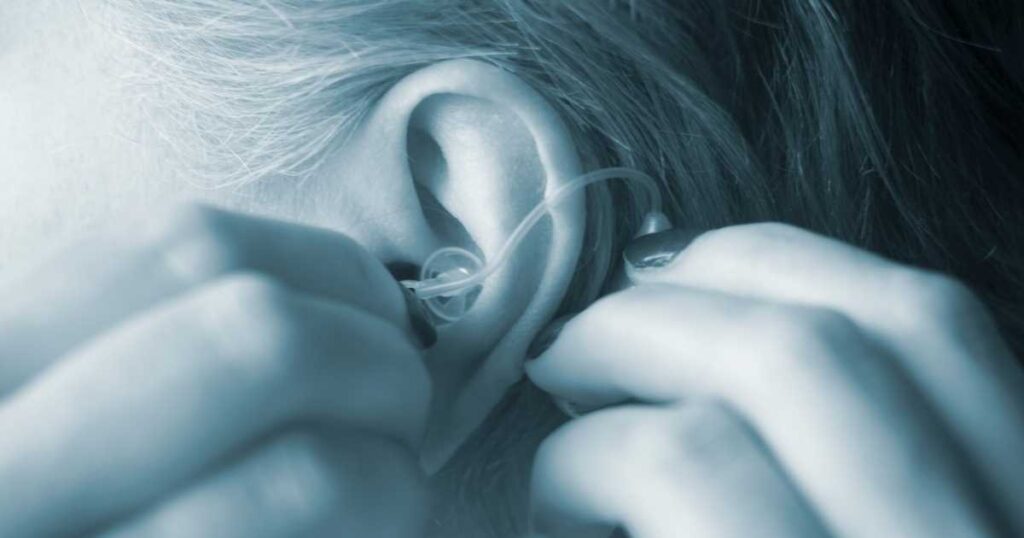
For the brain to habituate, it has to still hear the sound signal. This is a key difference between TRT sound therapy and tinnitus masking. Here are some key principles on TRT’s sound therapy component:
| Sound Therapy Component | Explanation |
|---|---|
| The Mixing Point | Sound therapy files should be set to the point at which you can just barely hear your tinnitus. This is called the “mixing point”. TRT participants are counseled not to mask tinnitus above this point. |
| Noise-enriched Environment | TRT is also big on silence avoidance and always practicing environmental sound enrichment. This helps reduce tinnitus perception. |
| Sound Files | Most TRT programs use simple white noise as the type of masking sound. Much of the technology in masking is designed to more effectively suppress the tinnitus sound, but in TRT, you want people to hear it so they can habituate to it. |
| Daily Duration | Most programs call for using sound therapy for a minimum of 4 hours a day, daily. Clinical data supports this. In a trial comparing 1,3, and 5 hours mixing point masking, the 5 hour group had statistically significant improvements in tinnitus symptoms over the other groups [2]. |
Tinnitus Maskers and Hearing Aids in TRT
There is no standard for tinnitus masking or sound stimulation in TRT. Here are the most common options:
| Device Option | Description |
|---|---|
| Tinnitus Masking Devices | Most of the time, people are offered ear-level white noise generators that look like a hearing aid. This may be appropriate for someone with normal hearing or only mild hearing loss. They can go behind the ear or in the ear canal. |
| Hearing Aids | These are dispensed to people who have tinnitus and moderate to severe hearing loss. However, in these cases, those with hearing loss are still instructed to use some other source of external sounds. |
| Combination Hearing Aids | Many hearing aids can be programmed to generate white noise at the mixing point. This way you get both amplification and masking while wearing hearing aids. Using a hearing aid allows you to accurately produce mixing point matching. |
| External Sound Machines | This is the use of conventional sound generators. Most options these days include settings where you can choose the color of noise (ie pink noise or brown noise) or select from nature sounds (rain, ocean, etc.). Here the masking noise is coming from external sound, rather than an ear-level device. |
One criticism of most TRT programs is that they’ll try to sell you an expensive hearing aid-type device. Theoretically, there is no reason why the sound generated for TRT can’t be from external noise generators or other sources of background sounds.
How much does Tinnitus Retraining Therapy cost?
Tinnitus Retraining Therapy (TRT) costs anywhere from $3,000-$7,000. The cost depends on several factors, such as the inclusion of an ear-level sound generator and the number of sessions included in the program.
There are incidental costs that should be considered as well, such as having to leave work for 2 days for your initial work up and going to multiple follow up visits, other out-of-pocket expenses. These are reduced in online Tinnitus Retraining Therapy courses.
Does Tinnitus Retraining Therapy work?

Yes, it works! According to a systematic review [3], TRT consistently shows positive results for treating moderate to severe tinnitus. The question is, does it work better than other treatments for tinnitus?
To answer this, we turn to the Tinnitus Retraining Therapy Trial, one of the largest and well designed controlled clinical trials on TRT to date. Here, TRT was testing against standard tinnitus masking programs [4].
The results of the study showed that all groups studied showed significant improvement in a variety of measures (Tinnitus Handicap Inventory, Tinnitus Functional Index, Tinnitus Questionnaire). However, there was no significant difference in improvement between the two groups. In other words, TRT worked, but not better than standard therapy.
I’d say the main flaw with the TRTT study is that it involved many military personnel. The tinnitus prevalence is high with this population, but so is post traumatic stress disorder (PTSD). This was not accounted for explicitly in the study and may have skewed results.
What is the difference between TRT and CBT for tinnitus?
There are similarities between TRT and Cognitive Behavioral Therapy (CBT). The American Tinnitus Association characterizes TRT as “A treatment regimen that combines the use of traditional CBT counseling with supplemental sound masking to habituate patients to tinnitus”.
I think this is inaccurate. The Tinnitus Counseling of TRT is very technical, like a graduate level class. The focus is very narrow and does not come close to the full spectrum of psychological tools available in CBT for tinnitus.
These tools may be more valuable than the ones used in TRT counseling. In one clinical trial, CBT was compared to TRT. At 6 months, tinnitus severity (measured by the Tinnitus Handicap Inventory) resulted in better improvements in the CBT group than the TRT group (reduction 54.5% vs. 20%). This illustrates either the power of CBT techniques or deficiencies in TRT tinnitus counseling.
At NeuroMed, we include the best of both worlds, using elements of TRT and CBT. The best intervention for reducing tinnitus severity is to use a combined-methods approach.
What is online Tinnitus Retraining Therapy?
Online Tinnitus Retraining Therapy (TRT) is a form of Modified Tinnitus Retraining Therapy (MTRT). These are tinnitus management strategies that take the good parts of conventional TRT, but modify the process to be shorter, less expensive, and more accessible.
For instance, one example of MTRT is where tinnitus patients cram all of the tinnitus counseling into a 7 day program where they visit with a multidisciplinary team of healthcare professionals.
Another example of MTRT is online tinnitus retraining therapy. This allows for all of the tinnitus counseling to take place in a much more convenient format. There are also app-based TRT programs that have shown similar success to conventional TRT [5].
At NeuroMed, we integrate MTRT into our protocols by providing tinnitus counseling and education used in TRT plus sound therapy. However, this tinnitus intervention is nested in a much more comprehensive program, that includes:
- App-based CBT
- Medication therapy
- Nutraceuticals
- Dietary interventions
- Sleep optimization
- Mindfulness therapy
- Motivational interviewing
- Lifestyle medicine
Results from our multimodal rehabilitation program are showing success rates in the 85-90% range.
What is the #1 Flaw with Tinnitus Retraining Therapy?
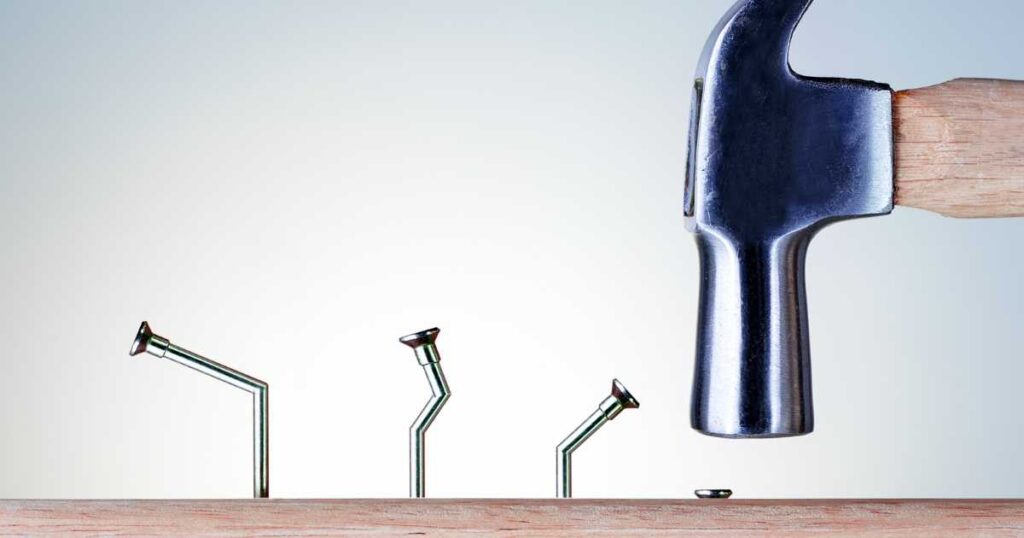
The #1 misconception of most tinnitus treatment strategies (TRT included) is that they don’t have a full picture of what causes tinnitus. Everything that TRT says is true about the brain, but they lack a key piece of information; what drives the tinnitus process.
Over the past 5 years at my academic clinic, we’ve published scores of academic papers that outline the role of migraine in tinnitus pathophysiology. Migraine and tinnitus severity are linked. Migraine is not just about headaches. In fact, for some people, tinnitus may be the only manifestation of migraine.
What we now understand about migraine is that it’s a sensory processing disorder driven by neurogenic inflammation. Here is what happens in summary format:
| Stage in Tinnitus Development | Description |
|---|---|
| Tinnitus Initiation | Some form of inner ear damage leads to hearing loss. This hearing nerve hypersensitivity is registered in the brain as a phantom sound, but it’s typically ignored. |
| Neurogenic Inflammation | Migraine episodes, triggered by environmental factors or internal stressors, cause neurogenic inflammation in the brain. This heightens sensory signaling, amplifying the perceived loudness of the signal. |
| Increased Attention | Loud ringing increases brain attention, activating its “salience”. The salience network are specific regions of the brain that determine how much attention we pay to sensory signals. |
| Fear Activation | The fear center of the brain (the limbic system) is activated, registering the ringing as a threat. This drives our negative reactions to the tinnitus sound. |
| Neural Network Formation | Stable neural networks establish, making the ringing a permanent fixture and hard to ignore. |
| Persistent Perception | Even after migraine resolution, the tinnitus signal persists, albeit less intense and annoying. |
| Neural Network Strengthening | Continued focus and worry strengthen neural networks, potentially triggering migraines and creating a vicious cycle. |
| Clinical Significance | Clinically significant tinnitus emerges, impacting quality of life and emotional health. |
Without addressing the migraine process in the brain, all sound-centric tinnitus management strategies like TRT will fall short of the success rates we’re reaching with our protocols.
Conclusion: Treating Tinnitus with TRT Falls Short
All tinnitus specialists owe a debt of gratitude to Jastreboff for his pioneering work on managing tinnitus, in particular, debilitating tinnitus. The clinical protocol that emerged from his research as TRT invariable shows positive outcomes.
However, does it work better than other forms of tinnitus therapy? The evidence says no. And if it yields the same outcomes, but is more expensive and time consuming, why use it? And is the markup with expensive hearing aids or masking devices necessary? This logic lead to multiple different permutations collectively referred to as Modified TRT. Online Tinnitus Retraining Therapy is showing promise as a way to provide the benefits of TRT, without the drawbacks of high cost and significant time commitment.
However, the key flaw with TRT is that it does not include the most important discoveries about what drives tinnitus perception; the migraine process in the brain. Migraine is fundamentally a sensory processing disorder, not a headache disorder. Without addressing migraine in tinnitus management, results will always fail to reach the high success rates we see at Neuromed.
Addendum: The Neurophysiological Model of Tinnitus
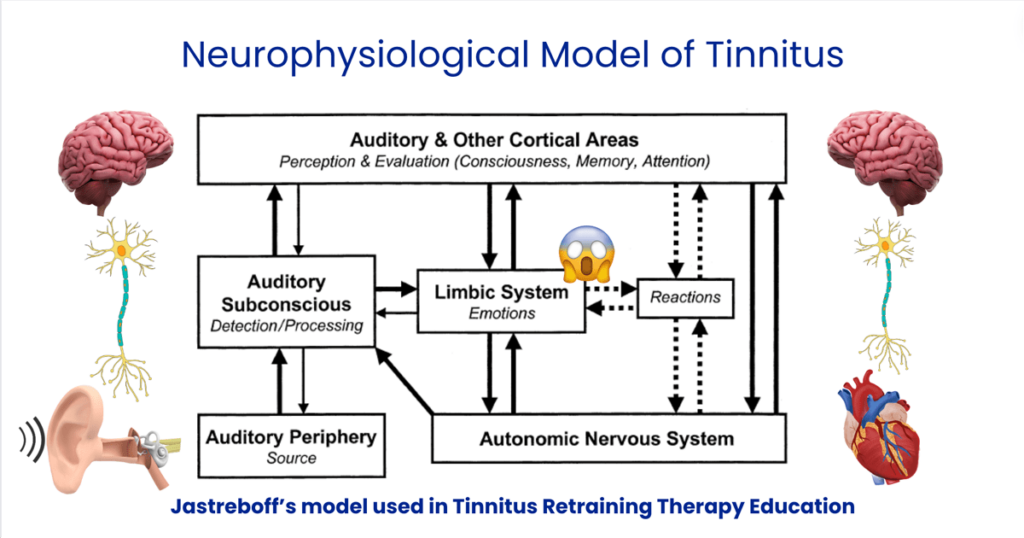
Tinnitus Retraining Therapy References
[1] Gold SL, Formby C, Scherer RW. The Tinnitus Retraining Therapy Counseling Protocol as Implemented in the Tinnitus Retraining Therapy Trial. Am J Audiol. 2021 Mar 10;30(1):1-15. doi: 10.1044/2020_AJA-20-00024.
[2] Jin IK, Choi SJ, Ku M, Sim Y, Lee T. The Impact of Daily Hours of Sound Therapy on Tinnitus Relief for People With Chronic Tinnitus: A Randomized Controlled Study. J Speech Lang Hear Res. 2022 Aug 17;65(8):3079-3099.
[3] Han M, Yang X, Lv J. Efficacy of tinnitus retraining therapy in the treatment of tinnitus: A meta-analysis and systematic review. Am J Otolaryngol. 2021 Nov-Dec;42(6):103151.
[4] Suh MW, Park MK, Kim Y, Kim YH. The Treatment Outcome of Smart Device-Based Tinnitus Retraining Therapy: Prospective Cohort Study. JMIR Mhealth Uhealth. 2023 Jan 12;11:e38986.
[5] Tinnitus Retraining Therapy Trial Research Group; Scherer RW, Formby C. Effect of Tinnitus Retraining Therapy vs Standard of Care on Tinnitus-Related Quality of Life: A Randomized Clinical Trial. JAMA Otolaryngol Head Neck Surg. 2019 Jul 1;145(7):597-608.






